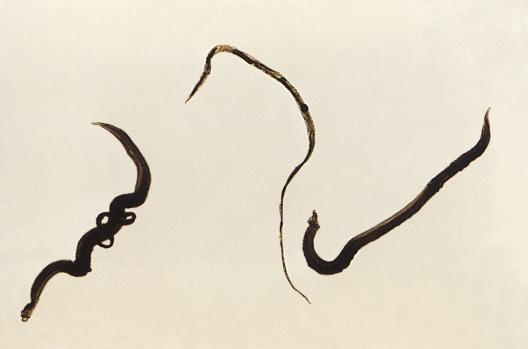Schistosomiasis, also known as bilharzia or snail fever, is an acute and chronic disease caused by parasitic flatworms called schistosomes or blood flukes. Most human infections are caused by Schistosoma mansoni, S. haematobium, or S. japonicum. The parasites spend part of their lifecycle in freshwater snails. The infectious, larval form emerges from the snail and contaminates water.
People who contact contaminated water during recreational, agricultural, or domestic activities become infected when the fork-shaped larval worms penetrate their skin, travel to blood vessels, and develop into adults. The release of eggs from female worms triggers symptoms in infected people, which can include abdominal pain, diarrhea, and blood in the urine. In children, repeated infections may cause anemia and stunted growth. Chronic infections frequently result in serious damage to the liver, intestines, and bladder. Women who are exposed to infested water through such routine tasks as clothes washing can develop urogenital schistosomiasis, which may result in tissue damage that increases the risk of HIV transmission.
Why Is the Study of Schistosomiasis (Bilharzia) a Priority for NIAID?
Although the parasites that cause human schistosomiasis are not found in the United States, at least 220 million people are infected worldwide, particularly in rural communities where people routinely collect water from lakes, rivers or small bodies of water for household or agricultural use. Among parasitic diseases, schistosomiasis is second only to malaria in terms of the high disease and economic burden it imposes
How Is NIAID Addressing This Critical Topic?
NIAID-supported investigators study many aspects of schistosomiasis to find new ways to prevent and treat the disease. Research is directed at the various life-stages of parasite itself as well as the freshwater snails that serve as an intermediate host.
Like other so-called neglected tropical diseases (NTDs), schistosomiasis generally impacts the world’s poorest people. Learn about NIAID research efforts on other NTDs.
The NIAID-funded Schistosomiasis Research Center provides investigators with a number of resources to advance their studies, including egg and larval parasites, snails and molecular reagents and other tools needed to conduct research.
This video describes the resources available from the Schistosomiasis Research Center.
VIDEO: Scientists studying schistosomiasis rely on NIAID for an unusual research resource—snails.
Page Summary
Schistosomiasis, also known as bilharzia or snail fever, is an acute and chronic disease caused by parasitic flatworms called schistosomes or blood flukes. Most human infections are caused by Schistosoma mansoni, S. haematobium, or S. japonicum. The parasites spend part of their lifecycle in freshwater snails. The infectious, larval form emerges from the snail and contaminates water.


